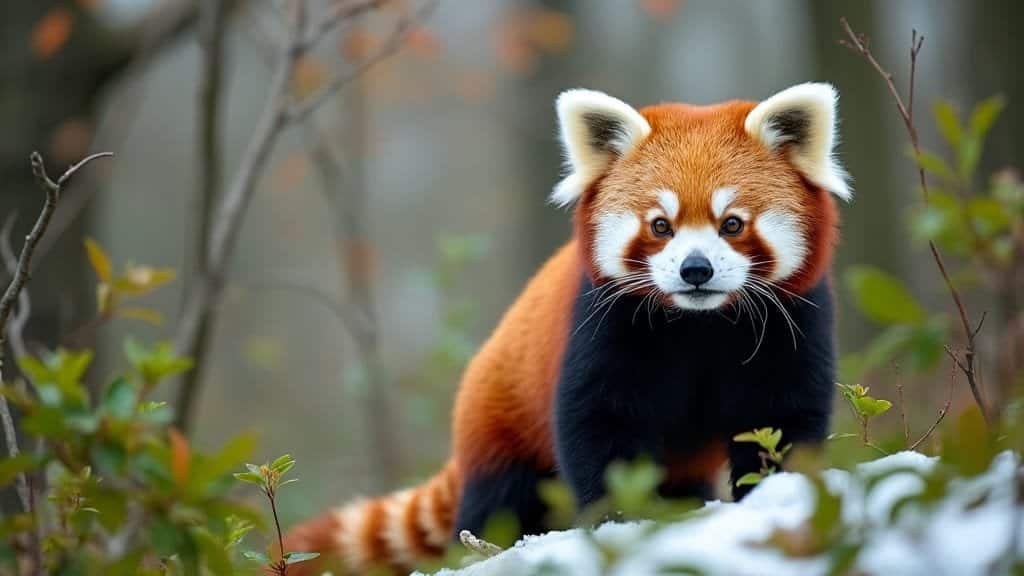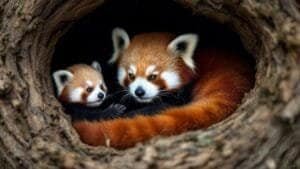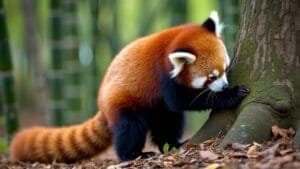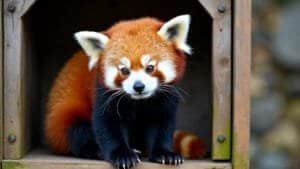The red panda’s reproductive cycle is closely tied to environmental conditions such as photoperiod (day length), temperature, food availability, and habitat stability. As a seasonal breeder, the red panda times its mating season to ensure that cubs are born when environmental resources are most abundant. Changes in photoperiod act as a biological trigger for reproductive hormones, while temperature fluctuations can influence mating success and cub survival rates
Additionally, habitat fragmentation and climate change pose increasing threats to red panda reproduction by altering their natural breeding cycles and limiting mating opportunities. In this article, we will explore how environmental factors shape red panda reproduction, the challenges posed by habitat loss, and conservation efforts aimed at protecting their breeding success
Environmental Factors That Influence Red Panda Reproduction
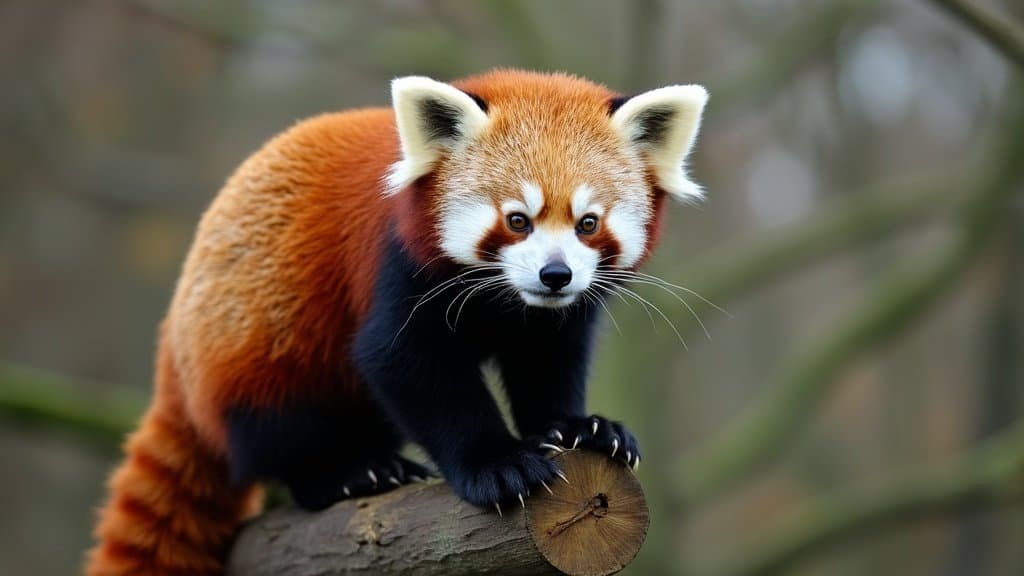
Red pandas depend on environmental cues to regulate their reproductive cycles, with factors such as daylight length, temperature, and food availability playing a key role in determining when mating occurs. As seasonal breeders, they have adapted to time their reproduction to ensure that cubs are born during periods of optimal resource availability
In the wild, their mating season is closely linked to photoperiod changes, with reproductive activity increasing as days grow longer. This natural synchronization ensures that cubs are born in late spring or early summer when bamboo, their primary food source, is most abundant
How Photoperiod Regulates the Breeding Season
Daylight duration is one of the most critical regulators of red panda reproduction. As the days lengthen after the winter solstice, their bodies respond by triggering hormonal changes that prepare them for mating. This increase in daylight stimulates the hypothalamus, which releases gonadotropin-releasing hormone (GnRH), setting off a chain reaction that leads to the production of luteinizing hormone (LH) and follicle-stimulating hormone (FSH)
These hormones regulate ovulation in females and sperm production in males, ensuring that mating occurs at a time that maximizes the survival chances of their offspring. Since red pandas rely on bamboo as a primary food source, their reproductive timing aligns with the period when fresh bamboo shoots and leaves are most available, supporting the energy-intensive process of lactation and cub rearing
Research on captive red pandas has demonstrated the strong influence of photoperiod on their breeding cycles. When exposed to artificial lighting conditions that do not mimic natural seasonal changes, some individuals experience irregular estrus cycles, while others fail to show reproductive behaviors altogether. These findings highlight the delicate balance between red panda reproduction and environmental cues, emphasizing the importance of maintaining naturalistic conditions in conservation breeding programs
The Role of Temperature in Red Panda Fertility
Temperature fluctuations also impact the reproductive success of red pandas, with both extreme cold and excessive heat influencing their ability to breed. In their natural habitat, which consists of cool, high-altitude forests in the Himalayas and parts of China, red pandas thrive in moderate temperatures
During winter and early spring, the cooler climate supports their reproductive behaviors by preserving scent-marking longevity, an important factor in mate attraction. As scent marks remain detectable for longer periods in cold conditions, they provide more reliable communication between males and females during the brief breeding season
Conversely, rising temperatures, particularly those linked to climate change, present challenges for red panda fertility. Heat stress has been shown to suppress reproductive hormone production, leading to lower mating success. Captive studies indicate that prolonged exposure to high temperatures can increase cortisol levels, a stress hormone that negatively affects fertility in both males and females
Additionally, heat-related lethargy and decreased food intake may result in weakened reproductive behaviors, reducing overall breeding rates. The impact of temperature is particularly concerning in regions where deforestation and habitat loss force red pandas into lower-altitude areas with warmer climates, potentially disrupting their natural breeding cycles
Seasonal Changes and Mating Behaviors
Environmental conditions not only influence reproductive physiology but also shape red panda mating behaviors. During the breeding season, which typically occurs between January and March, males exhibit heightened territoriality, increasing their scent-marking activity to signal dominance and attract potential mates. They engage in vocalizations, including bleating and chirping sounds, which serve as auditory cues to nearby females. Physical displays, such as tail arching and standing on hind legs, further reinforce their presence and readiness to compete for reproductive opportunities
Females, in turn, respond to these signals by assessing the quality of scent marks and selecting mates based on dominance and territory control. They become more receptive to courtship behaviors, allowing males to follow them closely and engage in grooming interactions, a behavior that strengthens pair bonds before mating. Since female red pandas experience an extremely short fertile window, often lasting only 24 to 48 hours, precise environmental timing is essential to ensure successful reproduction
After the breeding season concludes, red pandas gradually return to their solitary lifestyles, reducing interactions and focusing on resource acquisition. This cycle of heightened social behavior followed by seasonal withdrawal highlights the species’ adaptation to an environment where survival depends on efficient energy use. The influence of environmental factors on their reproductive cycle underscores the importance of habitat conservation, as disruptions to natural conditions can have profound effects on their ability to sustain viable populations in the wild
For more information on the seasonal reproductive patterns of red pandas, you can refer to this detailed study from the Smithsonian National Zoo
Nutritional and Habitat Influences on Reproduction
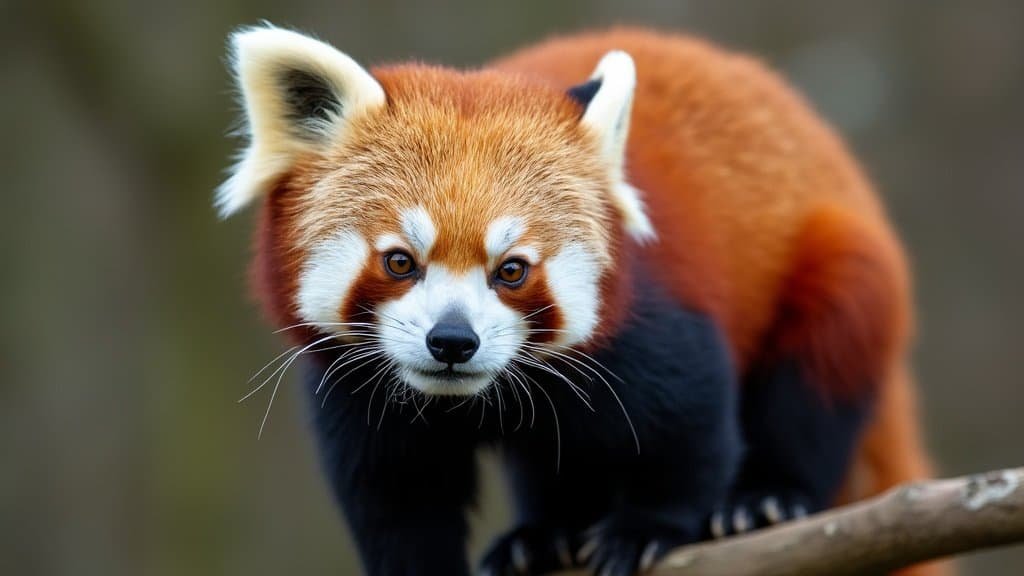
The availability of food and the stability of habitat play fundamental roles in the reproductive success of red pandas. As highly specialized feeders, they rely primarily on bamboo, a resource that undergoes seasonal fluctuations in growth and nutritional value. The timing of their reproductive cycle is closely synchronized with periods of peak bamboo abundance, ensuring that pregnant and lactating females have access to the energy-rich sustenance required to support their offspring
When food supplies are plentiful, female red pandas are more likely to conceive and successfully raise their young. However, habitat degradation and deforestation threaten this delicate balance, leading to nutritional stress that can suppress reproduction
How Food Availability Affects Breeding Success
Red pandas require a diet rich in bamboo, which provides the bulk of their nutritional intake. Unlike other carnivores, their digestive system is adapted to process fibrous plant material, making them heavily dependent on the seasonal growth patterns of bamboo forests. In the wild, bamboo shoots, leaves, and stems vary in availability throughout the year, with the most nutritious portions emerging in late spring and early summer. This seasonal cycle aligns with red panda birth periods, as newborn cubs require optimal maternal nutrition for survival
Pregnant females must accumulate sufficient fat reserves before giving birth to sustain the energy-intensive demands of lactation. If food sources are inadequate due to environmental changes, reproductive rates decline as females may delay or entirely forgo pregnancy to conserve resources
Studies on red panda populations in Nepal and Bhutan have shown that fluctuations in bamboo availability directly impact birth rates. In years when bamboo flowering events cause widespread die-offs of bamboo groves, red panda reproduction suffers due to a lack of adequate food sources. Unlike generalist species that can switch to alternative food options, red pandas have a limited dietary range, making them highly vulnerable to habitat disruptions. Conservationists have emphasized the importance of bamboo forest protection and replanting efforts to maintain stable food supplies and support healthy breeding cycles
Habitat Fragmentation and Its Impact on Mating
Habitat fragmentation poses a significant challenge to red panda reproduction, as deforestation and human encroachment divide their natural home ranges into smaller, isolated patches. Red pandas are solitary by nature, with individuals maintaining territories that they mark with scent signals to communicate with potential mates
When forests are fragmented, these territories become disconnected, reducing the likelihood of mating encounters. Males and females may struggle to locate each other during the breeding season, leading to lower reproductive success. Additionally, isolated populations are at greater risk of inbreeding, which can decrease genetic diversity and weaken overall population health
The construction of roads, agricultural expansion, and illegal logging activities have all contributed to the shrinking of red panda habitats. In regions where forest corridors have been disrupted, red pandas are often forced to travel across open landscapes, making them more vulnerable to predation and human-related threats. Research has shown that individuals in fragmented habitats exhibit higher stress levels and altered scent-marking behaviors, which may further impact their ability to reproduce successfully
Conservation programs focused on habitat restoration aim to reconnect fragmented territories through the creation of wildlife corridors, allowing red pandas to move freely and maintain natural mating patterns
Climate Change and Red Panda Reproductive Cycles
Climate change has emerged as an additional threat to red panda reproduction by altering seasonal temperature patterns, shifting food availability, and exacerbating habitat loss. Rising global temperatures affect bamboo growth cycles, potentially leading to mismatches between peak food availability and red panda birth periods. If bamboo forests experience irregular growth patterns due to climate fluctuations, the carefully timed reproductive cycle of red pandas may become disrupted, affecting cub survival rates
Another major consequence of climate change is the upward shift of suitable habitats to higher elevations. As temperatures rise, red pandas are being forced to migrate to cooler, mountainous regions, reducing the overall land area available for reproduction. This shift also increases competition for resources, as other high-altitude species move into these areas in response to changing climate conditions. The combined effects of habitat fragmentation and climate-induced range shifts place additional stress on already vulnerable red panda populations, making conservation efforts even more urgent
Efforts to mitigate the impact of climate change on red panda reproduction include habitat preservation, afforestation programs, and research into adaptive breeding strategies. Conservation organizations are working to monitor red panda populations using GPS tracking and camera traps to better understand how environmental changes affect their reproductive success. Protecting their natural habitat and ensuring stable food sources will be critical to maintaining healthy population levels in the face of ongoing climate challenges
For more information on the impact of habitat and climate change on red panda reproduction, refer to this scientific study from ScienceDirect
Conservation and Management of Red Panda Reproduction
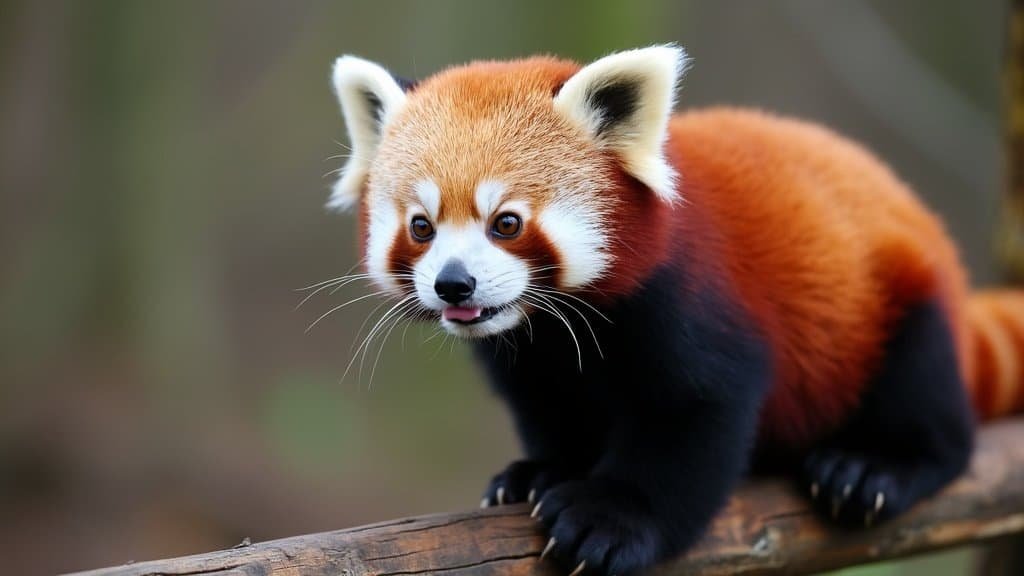
Efforts to protect red panda populations focus not only on preserving their natural habitats but also on managing their reproductive success in both wild and captive environments. Conservationists recognize that environmental disruptions, habitat fragmentation, and climate change have already impacted red panda breeding cycles
To ensure the survival of the species, various strategies have been developed to support their natural reproductive behaviors, improve genetic diversity, and mitigate the threats posed by human activities
Differences in Reproductive Cycles Between Wild and Captive Red Pandas
While wild red pandas follow a strictly seasonal reproductive cycle regulated by environmental cues, individuals in managed care settings sometimes exhibit slight variations due to artificial conditions. In the wild, photoperiod and temperature act as primary triggers for hormone production, ensuring that mating occurs at the optimal time for cub survival
In captivity, factors such as artificial lighting, climate control, and dietary consistency can alter the timing of reproductive behaviors. Some captive breeding programs have observed red pandas displaying estrus outside their usual breeding season, a phenomenon likely caused by exposure to unnatural environmental stimuli
Despite these challenges, captive breeding programs play a crucial role in red panda conservation. Zoos and wildlife reserves use behavioral monitoring and hormone analysis to track reproductive readiness, ensuring that pairs are introduced at the most fertile time. Advances in assisted reproductive technologies, including artificial insemination, have also been explored as potential methods to increase genetic diversity in captive populations. However, maintaining naturalistic environments that closely mimic wild conditions remains the most effective strategy for promoting successful reproduction in captivity
Conservation Strategies to Protect Red Panda Breeding
Habitat protection remains the most critical factor in securing the future of red panda reproduction. Conservation organizations and governments have implemented measures to protect existing forests, establish wildlife corridors, and reduce human encroachment. Protected areas in Nepal, Bhutan, India, and China have been designated as conservation zones where red pandas can breed without the pressures of habitat destruction and resource competition
Community-based conservation initiatives have also played an important role in red panda protection. Programs that engage local communities in sustainable forestry practices help reduce deforestation while providing economic incentives to maintain natural habitats. Anti-poaching laws and stricter regulations on illegal logging have contributed to stabilizing some red panda populations, though enforcement remains a challenge in certain regions
Another key conservation strategy is the reintroduction of captive-born red pandas into the wild. While this approach has had mixed success due to the difficulty of acclimating captive individuals to natural environments, ongoing research aims to improve survival rates by selecting individuals with strong natural instincts and minimizing human interaction before release. These efforts are complemented by long-term population monitoring, which uses GPS tracking and camera traps to study red panda movement patterns, reproductive success, and environmental adaptations
The Future of Red Panda Reproductive Health
Ensuring the long-term reproductive success of red pandas requires a combination of habitat preservation, climate resilience planning, and captive breeding support. As global temperatures continue to rise, conservationists are exploring ways to help red panda populations adapt to shifting environments, including the possibility of assisted migration to cooler regions. Genetic research is also being conducted to identify populations at risk of inbreeding, allowing for targeted breeding programs that maintain genetic diversity
Public awareness and education initiatives remain vital in fostering global support for red panda conservation. Organizations such as the Red Panda Network and the World Wildlife Fund have launched campaigns to promote habitat protection, encourage responsible tourism, and raise funds for research efforts. Continued collaboration between governments, conservationists, and local communities will be essential in securing the future of this endangered species
For further information on conservation programs protecting red panda reproductive cycles, explore this detailed report from Animal Diversity Web
